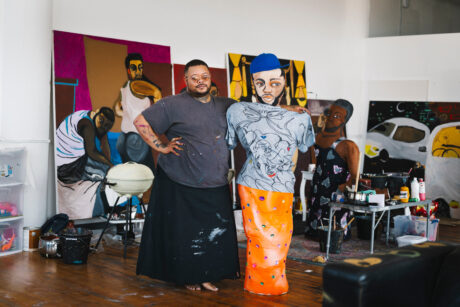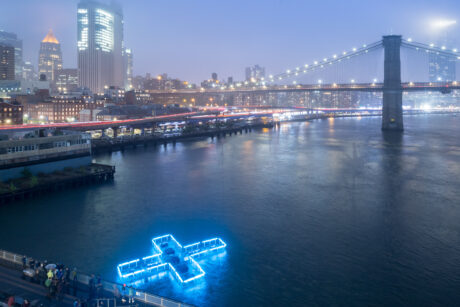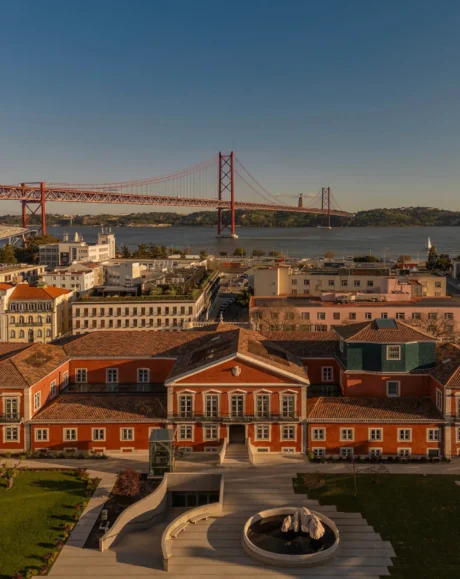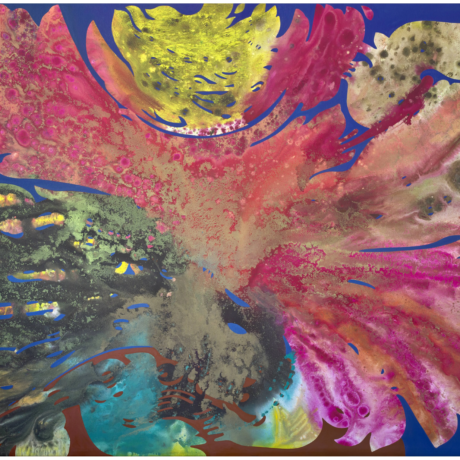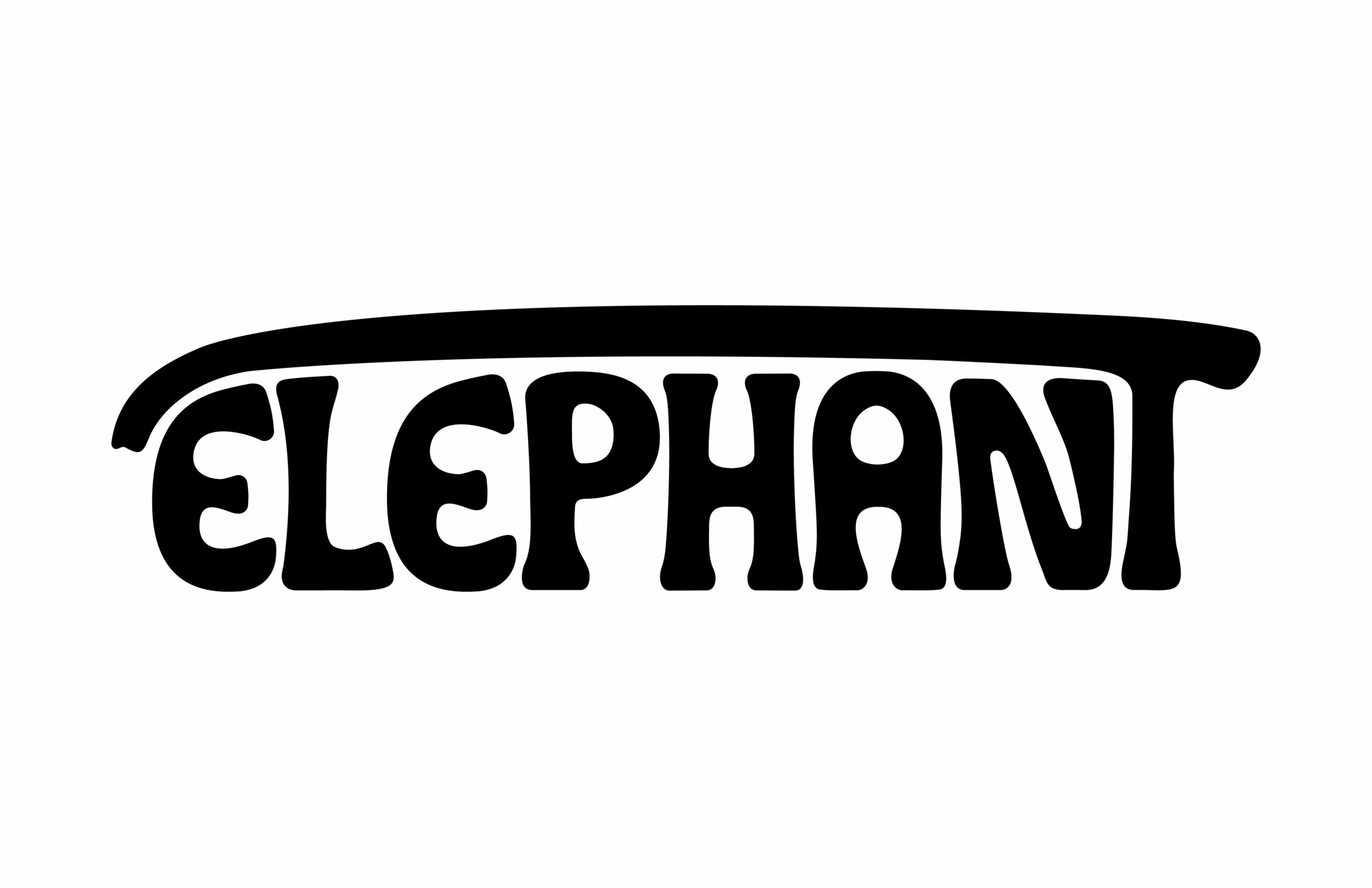Reframe is a monthly column in which contributor Sam Falb discusses timely openings to view in New York. Each edition offers commentary on the latest exhibitions, performances, and installations. Dynamic and ever-evolving, the content reflects the fluidity of the market it travels through.
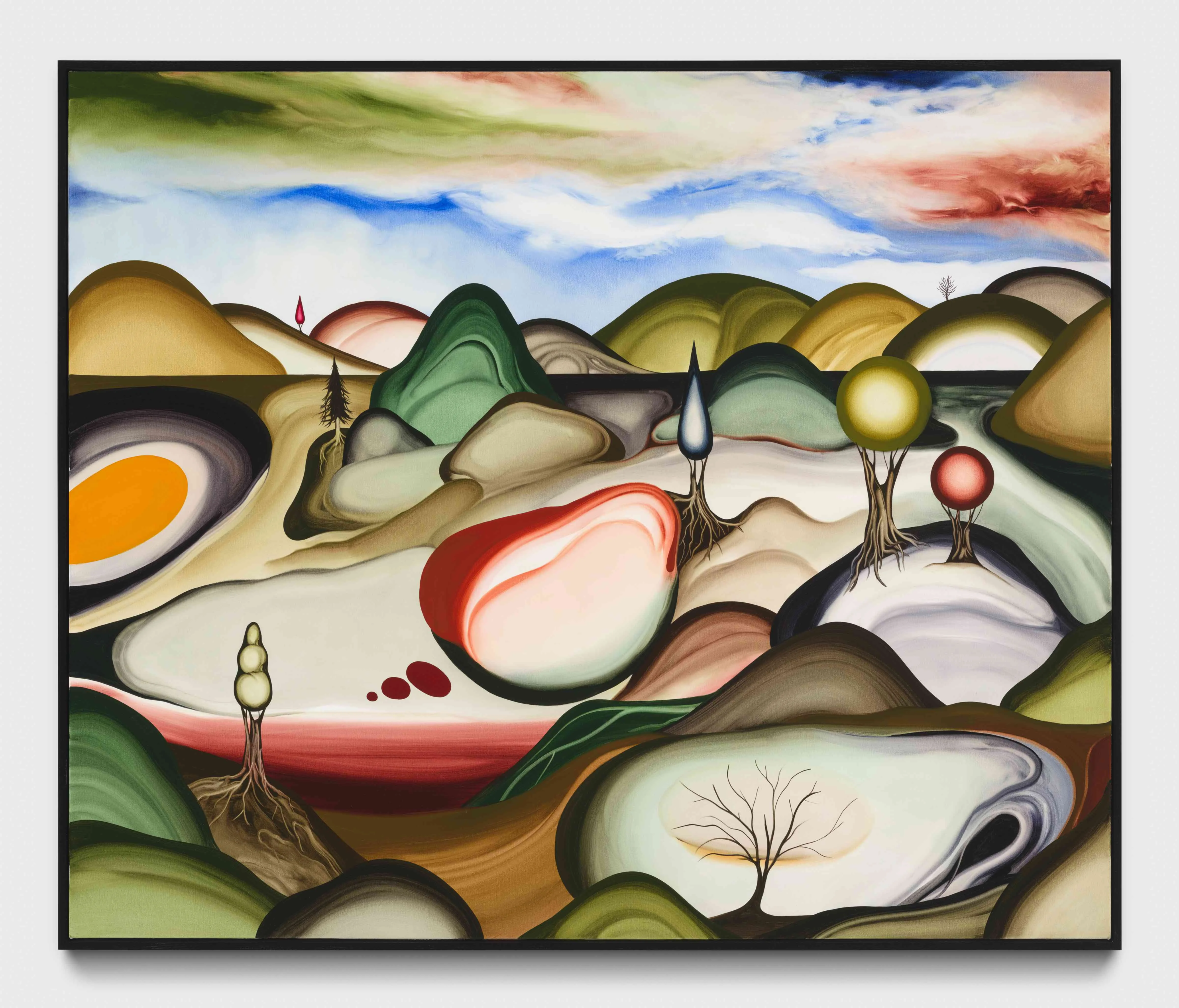
It’s hard to imagine that we are already approaching shows with beginning (or end) of summer timelines, but here we are nevertheless. As the sun begins to poke through the swirling, gray clouds of a classic New York winter, displays of artistic triumph follow suit – hurrah. This month’s edition features an array of exhibitions across material focuses, geographic origins, and storytelling that belies little in terms of vulnerability or pain-staking creative production. Gallerists Tara Downs and Francisco Correa Cordero offer their guidance on where to take one’s wandering feet in search of a compelling array of works to view, and we thank them for it. Thoughtful eyes peek out from color-washed canvases, turtles swim lazily through mysterious, dystopian muck, and vistas of natural beauty rendered in heaping, whirling geometric experimentation all find their place within this month’s edition.
Wschód: Skład pamięci (April 5-May 17)
Skład pamięci marks Keta Gavasheli’s U.S. debut, with a spectral dialogue between past and present. Taking cues from Tadeusz Kantor’s 1967 happening The Letter, the Tbilisi-born, Düsseldorf-based artist transforms archival echoes into a multi-sensory experience, with photographs of the highly peculiar walking performance that took place through the streets of Warsaw almost sixty year ago. Inkjet-printed panoramas, sculptural objects, and video works trace the aftershocks of Kantor’s avant-garde display, while soundscapes recorded around The Letter reverberate through Wschód’s Orchard Street space. Gavasheli’s latest body of work, rooted in an exploration of the spoken word, extends the Polish avant-garde’s legacy through contemporary media, with a display of archival photography by Eustachy Kossakowski and a performative text by Antoni Michnik deepening the exhibition’s concept. As past transmissions meet present interpretations, Skład pamięci reimagines and challenges memory. The exhibition by the dual Warsaw-New York gallery is part of a year-long programme by Wschód New York – stay tuned for further presentations of Polish avant-garde artwork at the gallery’s Lower East Side outpost.
Gratin: Body Cartography (March 20-April 27)
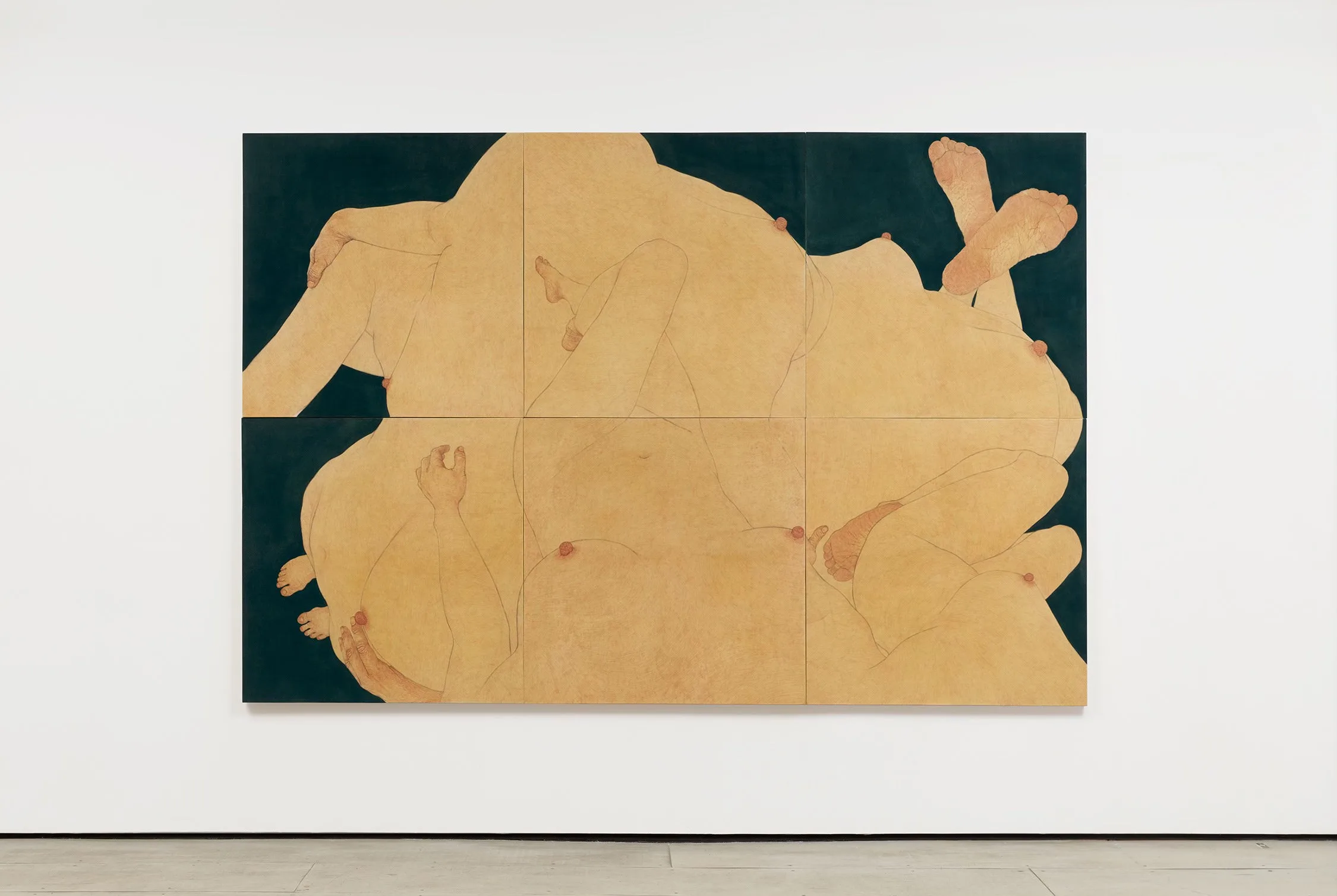
“I rarely have felt something that hard with art. It does what art is supposed to do to us–something you can’t explain,” Gratin founder Talal Abillama shares about the show. Experiencing Seung Ah Paik’s work, the sinews and grid-centered bodies, one would not be too remiss to see hints of pathways, contours, and other topographical references, as the title of the show so aptly references. The artist’s work uses the body’s tender architecture as a means of storytelling unto itself, that is, using wrinkles, intimacy, the landscape of an outstretched leg or cresting arm, as a methodology of self-exploration. In Body Cartography, Paik collapses the distance between presence and absence, self and landscape. The body is not fixed, but shifting—an expanse of lived experience, a text written in muscle and marrow. Through obscured perspectives and fractured anatomies, she invites the viewer into an act of recognition, where the familiar becomes strange and the personal becomes universal. Here, the body is not just a site, it is a story in motion, a living, breathing record of what it means to inhabit space, time, and oneself.
Efraín López: Primary Frequencies (March 20-April 26)
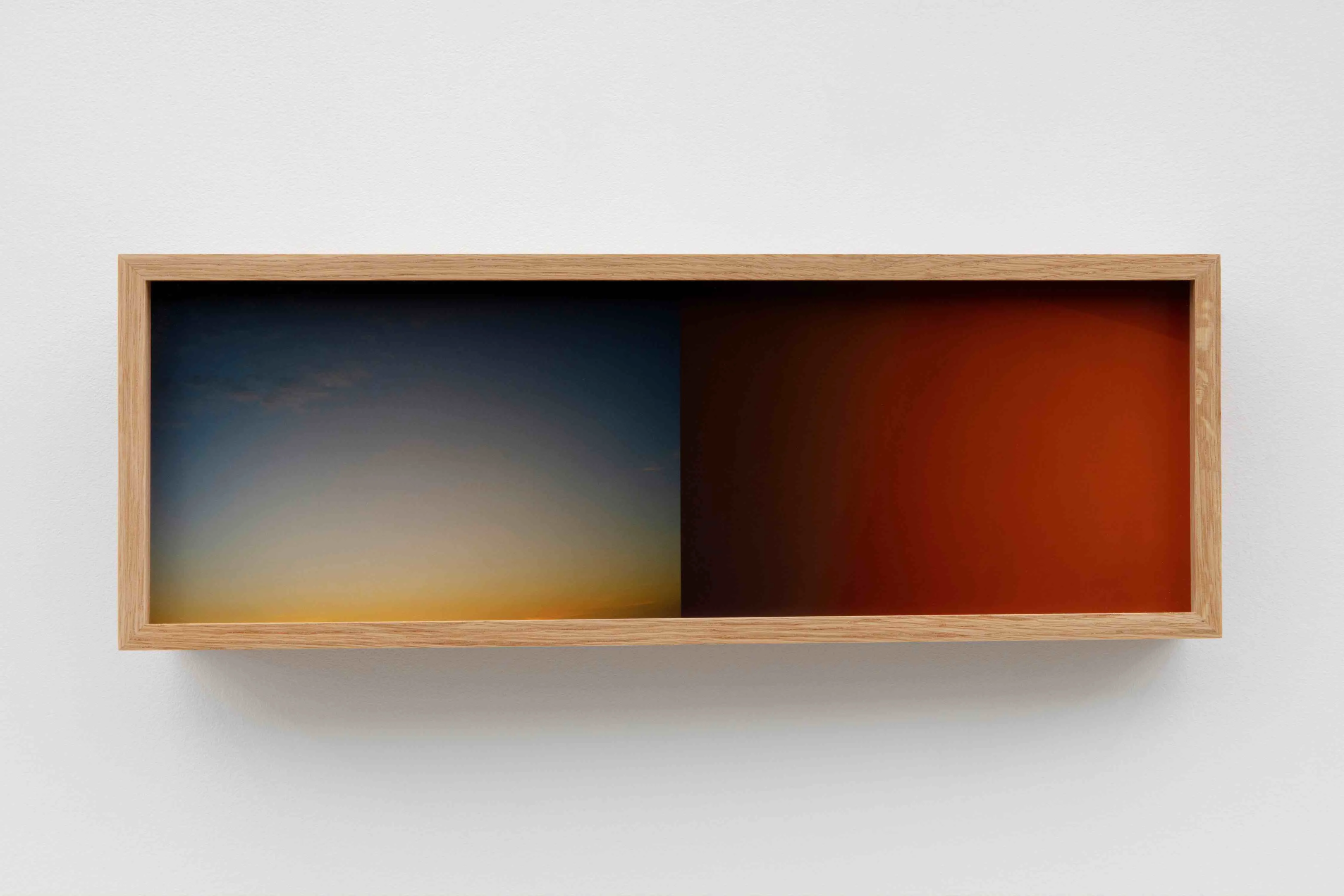
Artists receiving their due in a showing setting are central to this show, which viewers can find down a flight of stairs and through a door into the below-ground, sleekly strapping gallery where a selection of works from Gisela Colón, Manuela García, Leslie Hewitt, Mary Miss, Zilia Sánchez currently find their home. The show is intergenerational, featuring a variety of artists that all speak to Minimalism in its various wayward bends across color, material (Doble Curva is particularly intriguing in curved paper and metal hinges), and the inimitable Light Portal, which greets viewers upon entry into the space with a masterful glow of yellow tumbling into the softest suggestion of a violet plain. “Primary Frequencies posits that each artwork serves as a reservoir of potential energy,” exhibition text by Reilly Davidson explains. This premise unfolds through Colón’s radiant, light-activated sculptures, García’s tactile studies of form, Hewitt’s photographic interventions in spatial memory, Miss’s site-responsive installations, and Sánchez’s sculptural canvases – each a marker of Minimalism’s porous evolution. Their works converge in a space that encourages close looking and deep engagement, where the lineage of their practices is reconsidered not as a fixed aesthetic but as an open-ended conversation.
MoMA PS1: I was wearing this when you met me (March 27-August 25)
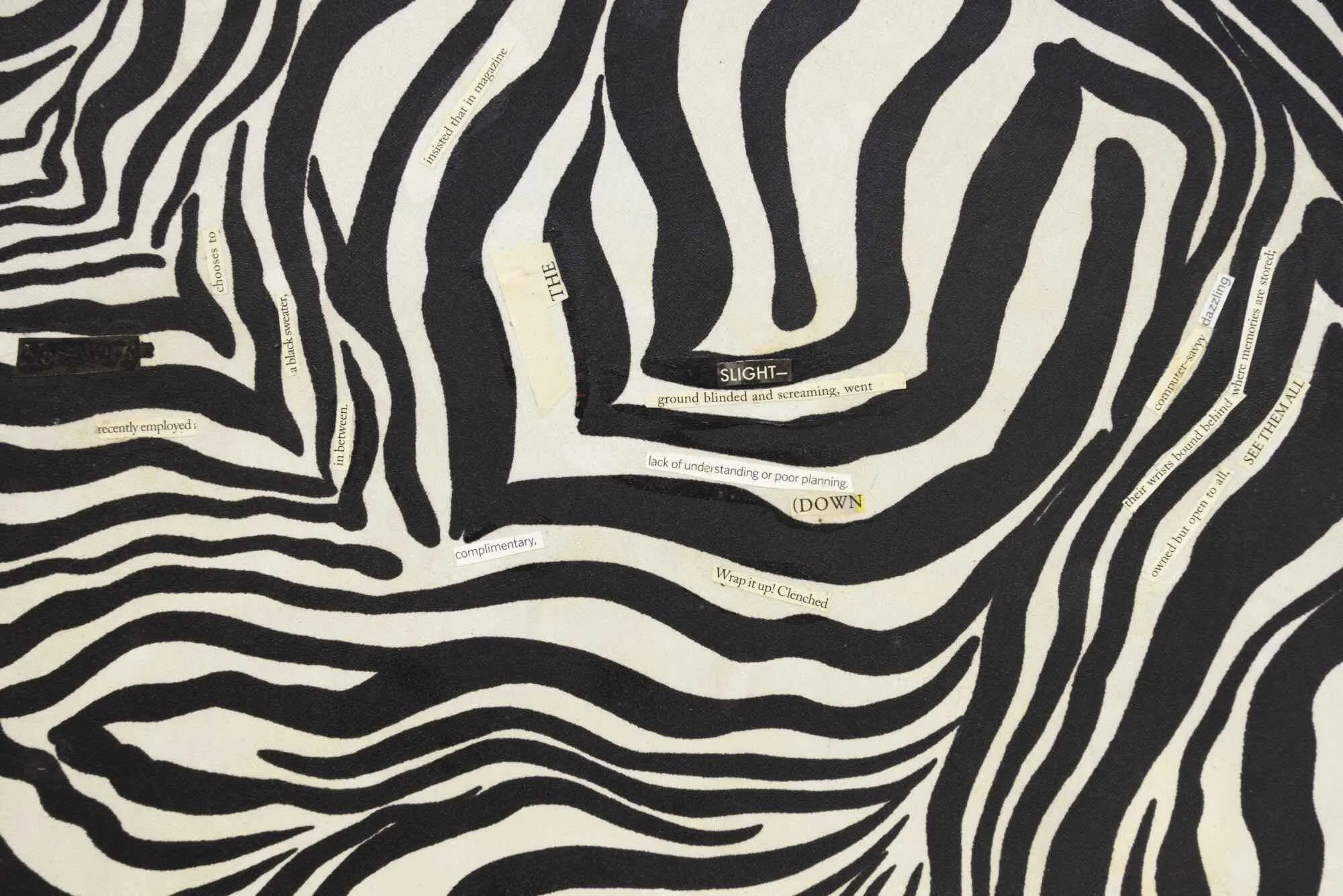
Whitney Claflin’s first solo museum exhibition is a collage (sometimes literally) of her portfolio of works across mediums, many of which employ materials including magazine clippings, sequins, red wine, and tissue paper on canvas in delightful configurations. Yogurt the Color of Night offers a zebraic tableau of black and white stripes with cut-outs of vocabulary and phrases peppered throughout – SLIGHT, DOWN, and “recently employed” all make a cheeky appearance. With representation by the downtown Derosia Gallery, Claflin has seen a string of solo, group, and international showcases ranging from 2019’s Holly Village group show, to 2023’s Bel Ami show Brick Wall, to 2024’s Paris Internationale exhibition. The throughline? An air of disciplined whimsy, if one may call it as such. Her measured hand crafts storytelling that can feel airy and playful on the surface, but with a little poking and prodding, reveals introspection and substance-driven wit, inviting the viewer to look closer and decode the layers beneath the surface. For I was wearing this when you met me, a powerhouse range of references serve as pillars of this theme. 1970s flower-power paraphernalia, Teenage Mutant Ninja Turtles, beloved New York bars, and the late-90s DIY scene of the artist’s youth showcase the sheer breadth of the creative limits the artist will traverse in order to develop her work. Breathless, technically savvy, and emotionally evocative, Claflin’s work balances the joyful exuberance of its form with a focus on deep inner feelings that all viewers can relate to, drawing viewers into an intimate exploration of the artist’s world, where each detail—whether playful or poignant—speaks to the complex tapestry of life and the emotions that shape us.
American Art Catalogues: Unhome (March 14-April 26)
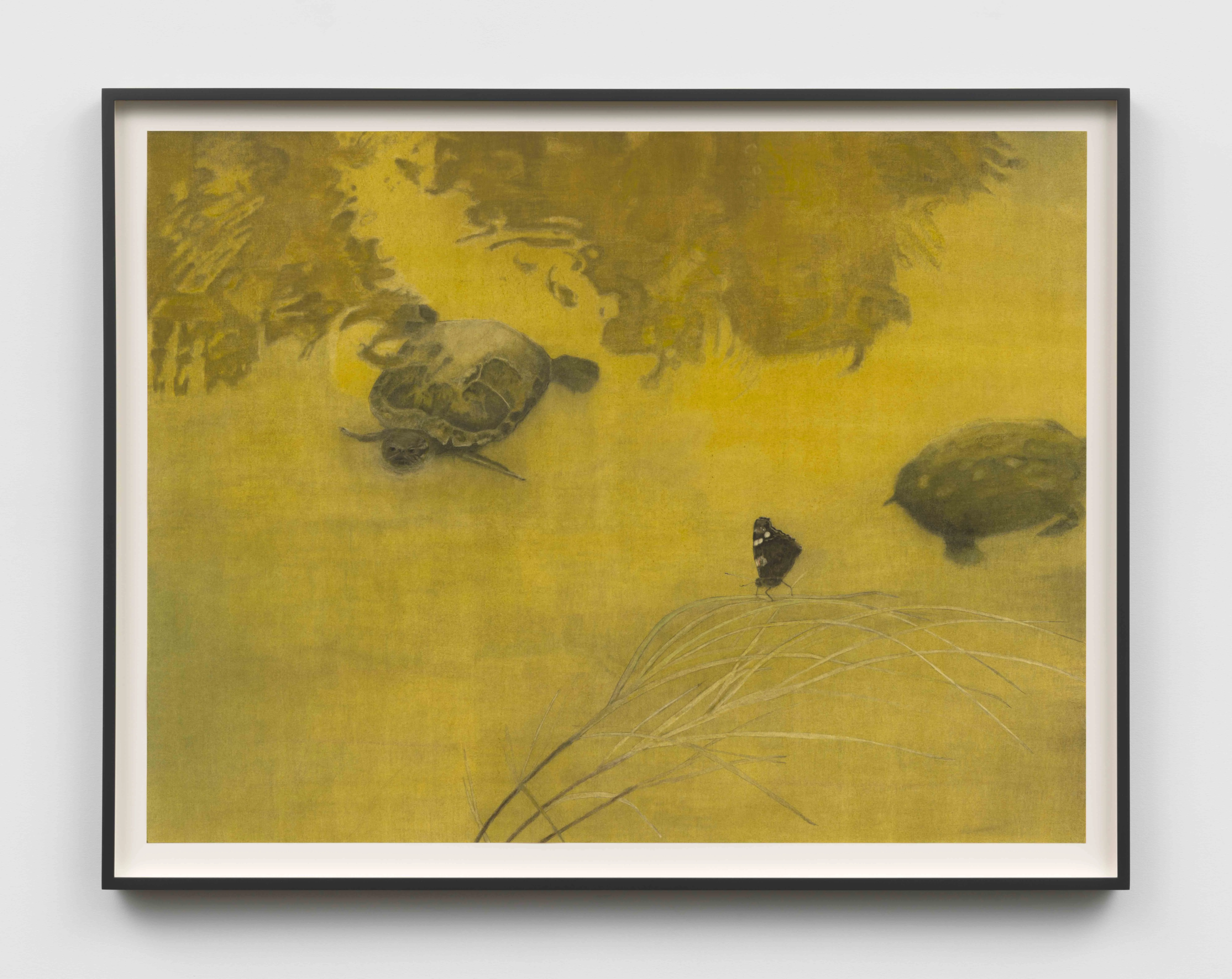
It’s important not to let the mind be fooled by the sunny, yellow disposition and handsome turtles that traverse the canvases of Christopher Culver’s Unhome, which now lives at American Art Catalogues’ West Village outpost alongside a monograph of the same name. The artist aims to showcase “waning environments,” that is, recognizable icons of industrial development (movie theaters, piping, cityscapes, and their soft crumbling amidst an unseen abandonment by human forebears. The turtles swim lazily through ponds of murky silt, the most delicate ripples and reflections of out-of-sight foliage punctuating each moment. As exhibition notes share, “their tranquil existence has eerie undertones.” Questions are raised as to how these creatures met this moment, whether other members of the animal kingdom survived the unexplained reckoning, and what state the Earth may be in at large in this stage of its history. The works are at once serene and unsettling, capturing a kind of post-human quietude where nature and industry have become one, their boundaries blurred by time’s erosion. Culver’s technique—at once nostalgic and contemporary—invites viewers to meditate on the fragility of civilization, as the scenes evoke the quiet aftermath of the unknown. The artist invites us into a future not defined by destruction, but by an uncanny peace—a moment where nature reclaims what was once its own, gently but firmly.
C L E A R I N G: Friends and Lovers, Resurrection (March 12-April 26)
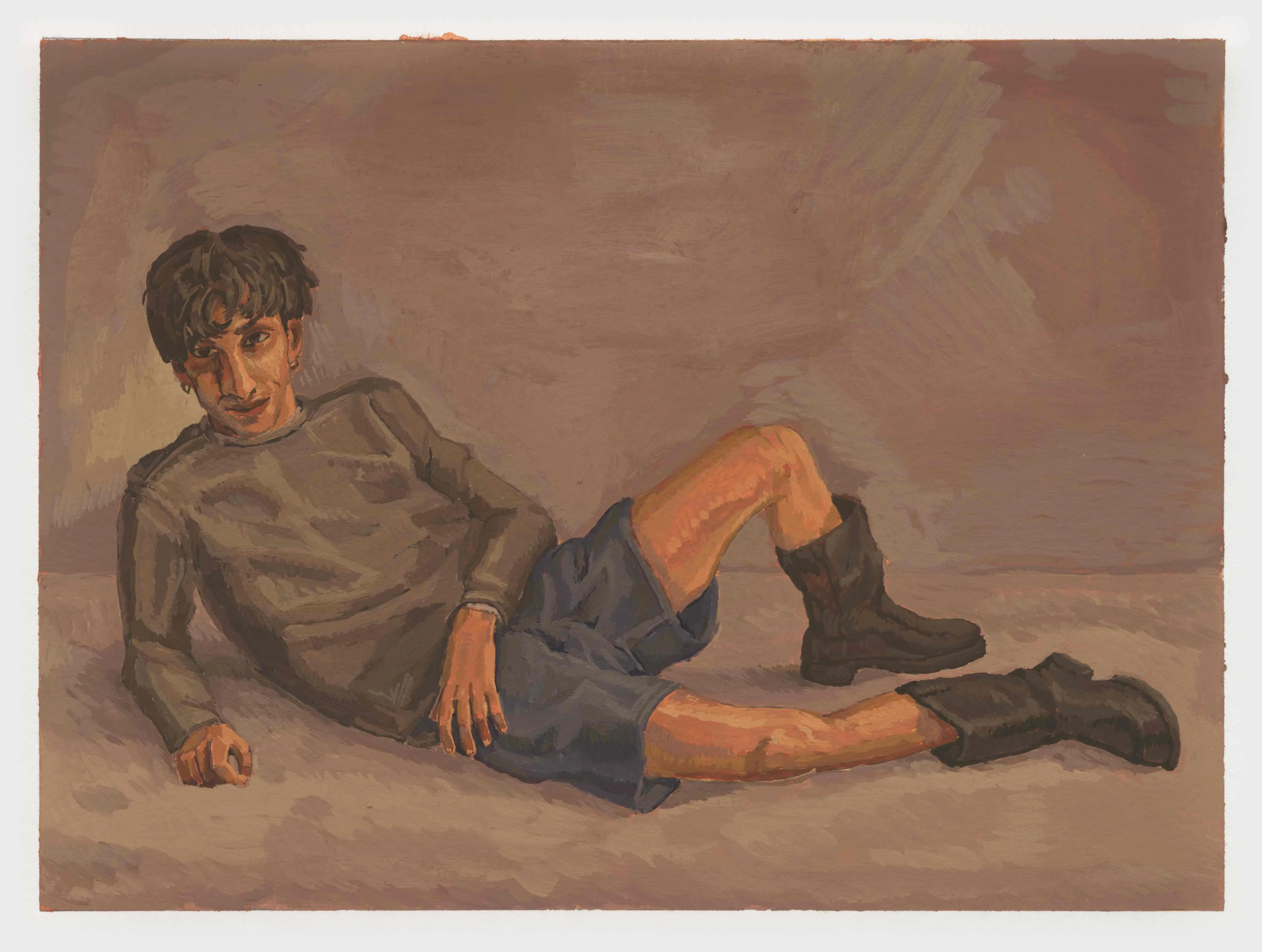
Walking through Felix Le Clerq’s Friends and Lovers, one might feel as though they’re getting to know a cast of associated characters in an unspoken ensemble – the cheeky young man (Lennert (II)), woman in pensive recline (Nele), or the quietly expressive, very shirtless (Jordan (III)). Each portrait, rendered with a cinematic intimacy, suggests a moment suspended between familiarity and performance. There’s a studied ease to their gestures, a subtle choreography of glances and postures that hint at the relationships just beyond the frame, as well as a thoughtful curation of simple garments that still speak to poignant character development. In this world, affection and ambiguity intermingle, leaving the viewer to parse the dynamics at play—are we witnessing lovers, friends, or something in between? Consider this question while visiting the presentation of Robert Zehnder’s Resurrection, also available in the space. Zehnder arrives at the gallery’s New York space for his first exhibition after a solo debut at the Los Angeles location of the gallery in 2023. If you’re viewing his work and wondering how the masterfully rendered natural landscapes, the green, pillowy hills and sweeping currents of reimagined vegetation can be both so approachable yet so digital, you would not be wrong to think so. “The artist’s engagement with gaming and digital escapism introduces a new kind of cartography—one shaped by constructed environments, boundless in their illusion yet governed by hidden parameters,” notes on the show share. Together, Friends and Lovers and Resurrection offer parallel meditations on perception—one through the intimate, coded language of human connection, the other through landscapes that blur the boundaries between the organic and the virtual.
David Nolan: Sky From Below (March 7-May 3)
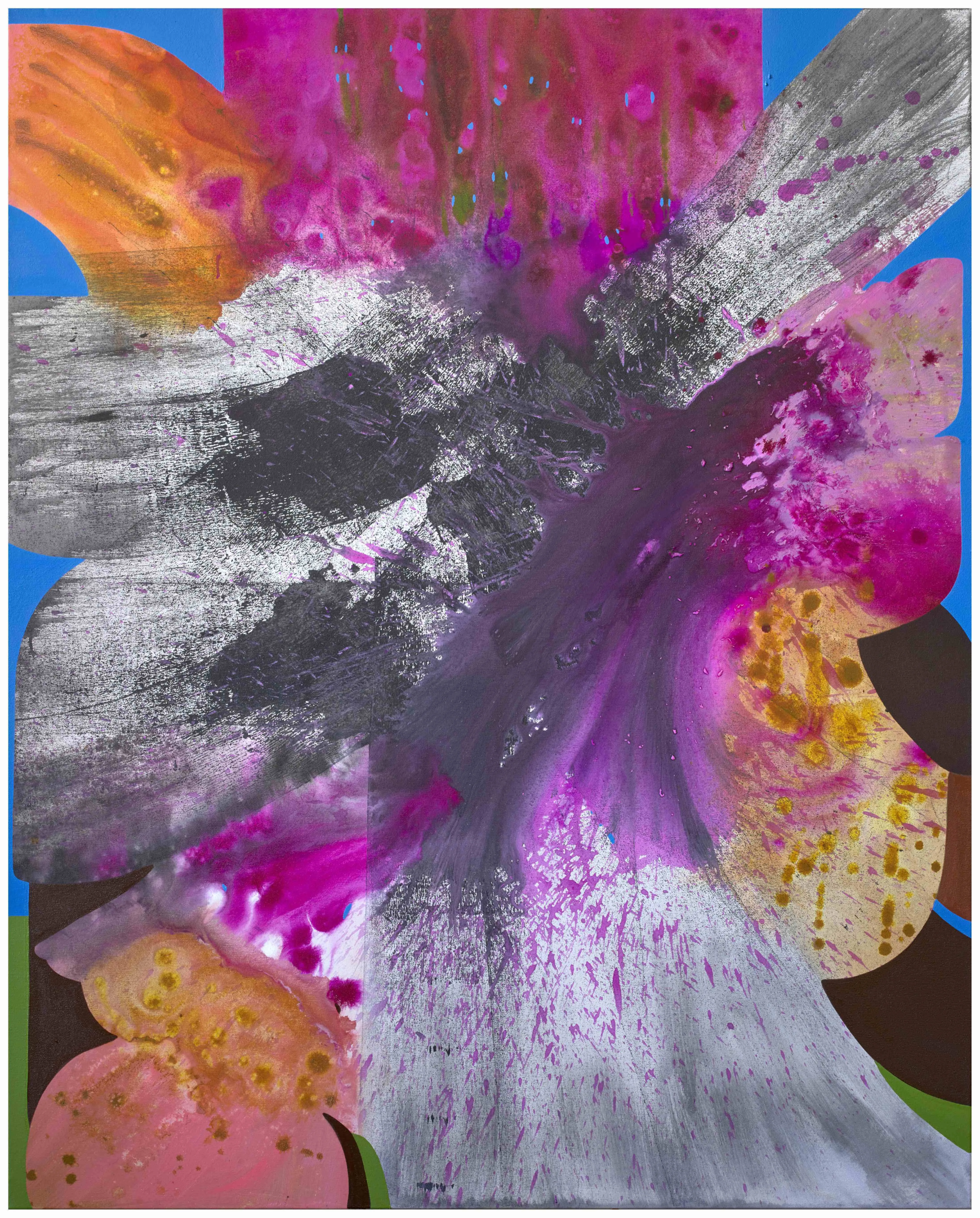
Flying above her homeland of Iraq, Vian Sora was inspired to develop a new series of paintings based on the familiar vista she could see below, and the ensuing reflections on a childhood experienced through political tumult and the dictatorship of Saddam Hussein. Sky From Below, the series that came out of this powerful observational period, captures landscapes which speak to the artist’s intimate connection to her home country, while continuing to explore an evolving relationship with displacement, memory, and resilience. The paintings blend abstraction with vivid, almost dreamlike topographies – flooded fields of color disrupted by dynamic gestures that evoke both destruction and regeneration (in flashes of fuschia, bright yellow, and deep greens and blues). The aerial perspective seems to have been orchestrated to allow for an examination of Iraq not just as a place of origin, but as a constantly shifting entity, shaped by history and the enduring spirit of its people, and global communities affected by harsh discourse and concerning swings in groupthink ideologies. “The work ties into the current political climate in responding to the high level of polarization around the world,” Sora explained. “It also responds to the shock and awe many feel toward current politics. Catch this show before the artist’s first first museum survey exhibition opens at the Santa Barbara Museum of Art in June.
INDUSTRY RECOMMENDATION: GALLERIST TARA DOWNS, TARA DOWNS
52 Walker: Already (April 11-June 7)
Anticipation builds for a mesmerizing exhibition at 52 Walker, set to open on April 11, featuring the evocative work of Canadian artist Lotus Kang (b. 1985). The show follows her breathtaking installation at the Whitney Biennale—where unfixed sheets of light-sensitive industrial film cascaded from industrial scaffolding, dynamically responding to the ambient light. In this upcoming exhibition titled Already, Kang will stage her installations around site-specific greenhouses, creating an environment that invites contemplation of the body’s relationship to time, memory, and identity. Through her innovative approach to film, Kang challenges conventional boundaries, transforming the viewing experience into a meditative dialogue on the ephemeral nature of human existence.
INDUSTRY RECOMMENDATION: GALLERIST FRANCISCO CORREA CORDERO, LUBOV
Maxwell Graham Gallery: This artwork did not sell. (March 12 – April 26)
I would expect the gallery’s “garage-sale” approach at an art fair, or disguised as a curated summer group show. But as an exhibition in which the premise is exactly that – the unwanted artwork from previous solo exhibitions – the vulnerability in acknowledging the failure to sell becomes a statement on the internal economics of galleries and benefactors. Having a gallery myself, I’ve sometimes felt compelled to turn it into an outlet store, hanging everything I have in storage in my desperation for quick cash without burdening my artists. But when I visualize what the show would look like in my head, I’m immediately repulsed by its aesthetic inconsistency. The exhibition at Maxwell Graham Gallery demonstrates the rigor, discipline, and commitment of Graham’s vision over the years. The curatorial premise is further distilled to its core by letting the placement of the artwork be determined by the previous decision of its original location, installed in the preceding solo show it belonged to.
Written by Sam Falb
